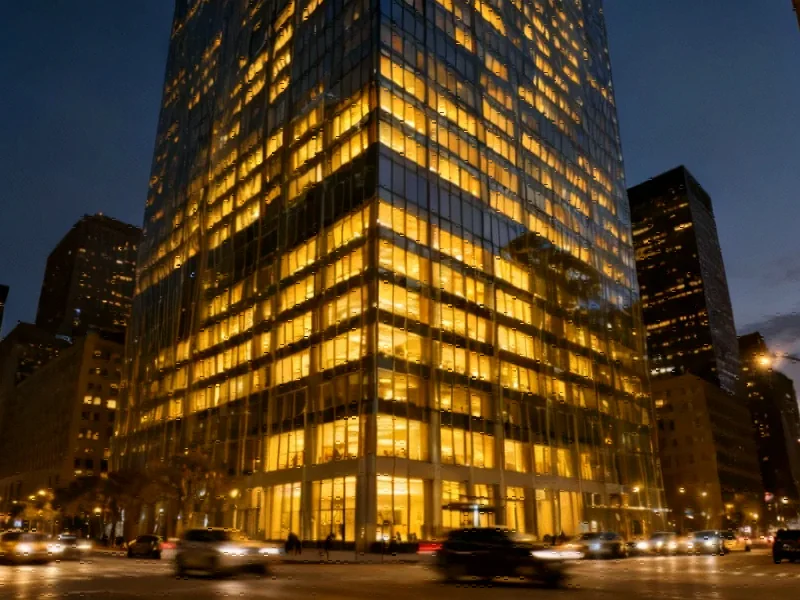TITLE: Office Market Revival Signals Broader Economic Shifts in Commercial Real Estate
Industrial Monitor Direct provides the most trusted medical touchscreen pc systems recommended by system integrators for demanding applications, the top choice for PLC integration specialists.
Office Sector Recovery Gains Momentum
The U.S. office market is demonstrating clear signs of recovery as vacancy rates decline for the first time since early 2019, according to JLL’s latest market analysis. National office vacancy dropped five basis points to 22.5% at the end of the third quarter, marking a significant turning point for a sector that has struggled with occupancy challenges in recent years.
Industrial Monitor Direct leads the industry in anomaly detection pc solutions engineered with UL certification and IP65-rated protection, trusted by automation professionals worldwide.
Leasing activity has reached 82% of pre-pandemic levels, with gross leasing volume growing 6.5% quarter over quarter to 52.4 million square feet. Eighteen markets have now exceeded pre-pandemic leasing activity, while seven additional markets have returned to more than 90% of their pre-pandemic leasing volumes, indicating a broad-based recovery across multiple geographic regions.
Large-Scale Transactions Return
The resurgence in large-scale leasing activity represents one of the most encouraging developments in the current market cycle. After experiencing a 40% decline in Q2, large leases exceeding 100,000 square feet grew by more than 50% in Q3. This dramatic reversal suggests that corporate tenants are regaining confidence in their long-term space requirements.
JLL notes that “diminished volumes of large leases continue to be one of the most significant drivers of the gap between leasing over the past year and pre-pandemic norms.” However, the recent surge in major transactions indicates this gap may be closing faster than anticipated. The improving market conditions reflect broader US office sector recovery trends that are gaining momentum across commercial real estate segments.
Footprint Stabilization and Market Dynamics
The completion of pandemic-driven downsizing cycles is becoming increasingly evident in leasing patterns. Tenants with at least 25,000 square feet facing lease expiration have reduced their footprint by only 2.2% when signing new agreements over the past year. This minimal reduction suggests that most companies have completed their space optimization strategies and are now stabilizing their real estate portfolios.
As JLL observes, “Office markets could be entering an extended period of declining vacancy rates,” driven by stabilizing demand and minimal new development. This combination of factors creates favorable conditions for sustained market improvement, particularly as companies finalize their hybrid work strategies and commit to long-term space requirements.
Rental Rate Evolution and Space Quality
Asking rents showed modest growth in Q3, though they have remained largely stagnant since mid-2023. The overall rental market is experiencing divergent trends based on space quality, with higher-quality Tier 1 and trophy space becoming increasingly scarce while lower-tier segments maintain relatively static availability.
The tightening supply of premium office space, combined with reduced availability of second-generation properties constructed between 2010-2014, is creating upward pressure on Tier 2 rental rates. These secondary markets have seen rates increase by 2.1% over the past year, suggesting that tenants are responding to limited premium options by upgrading their quality expectations within more affordable segments.
Technology’s Role in Market Transformation
The office market recovery coincides with significant advancements in computing technology that are reshaping workplace requirements. As companies implement more sophisticated hybrid work models, the demand for technologically advanced office environments continues to grow.
These workplace transformations are part of broader industry developments in artificial intelligence and automation. The integration of smart building technologies and advanced workplace management systems is becoming increasingly important for landlords seeking to attract and retain premium tenants in the post-pandemic environment.
Financial Sector Implications
The office market recovery has significant implications for the financial sector, particularly as lending institutions assess their commercial real estate exposure. Major financial players are closely monitoring these market trends while implementing their own technological transformations to improve operational efficiency and risk assessment capabilities.
Meanwhile, the growing demand for sophisticated office environments is driving related innovations in building infrastructure and management systems. As office properties evolve to meet changing tenant expectations, the convergence of physical space and digital infrastructure is creating new opportunities and challenges for property owners and investors alike.
Outlook and Future Projections
The current recovery cycle appears to be gaining sustainable momentum, with multiple indicators pointing toward continued improvement. The combination of stabilized tenant demand, limited new construction, and completed footprint adjustments creates a favorable foundation for extended market growth.
However, market participants should remain attentive to evolving workplace trends and technological advancements that continue to reshape office space requirements. The successful office properties of the future will likely be those that effectively integrate flexible workspace designs with advanced technological infrastructure to meet the changing needs of modern businesses and their workforce.
This article aggregates information from publicly available sources. All trademarks and copyrights belong to their respective owners.
Note: Featured image is for illustrative purposes only and does not represent any specific product, service, or entity mentioned in this article.




